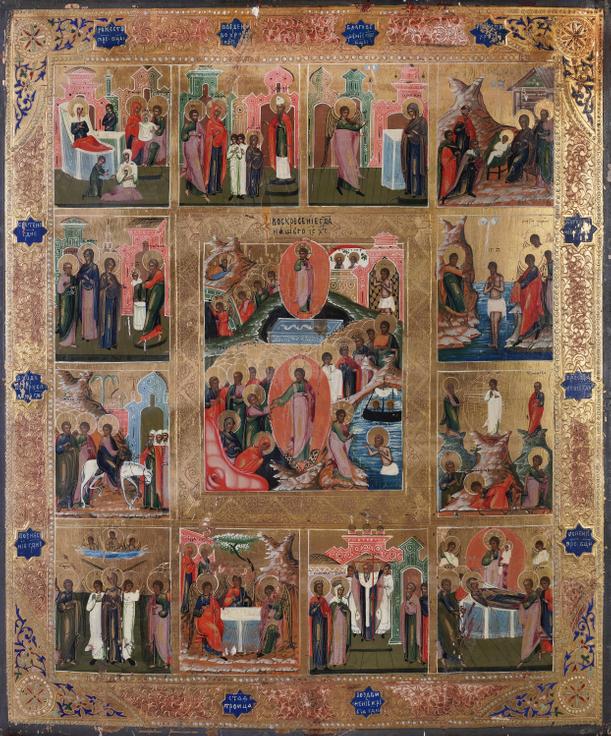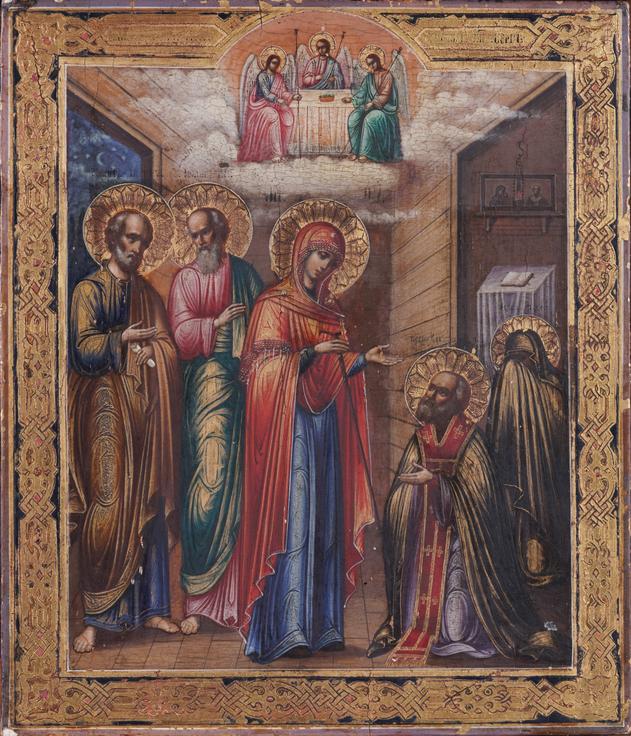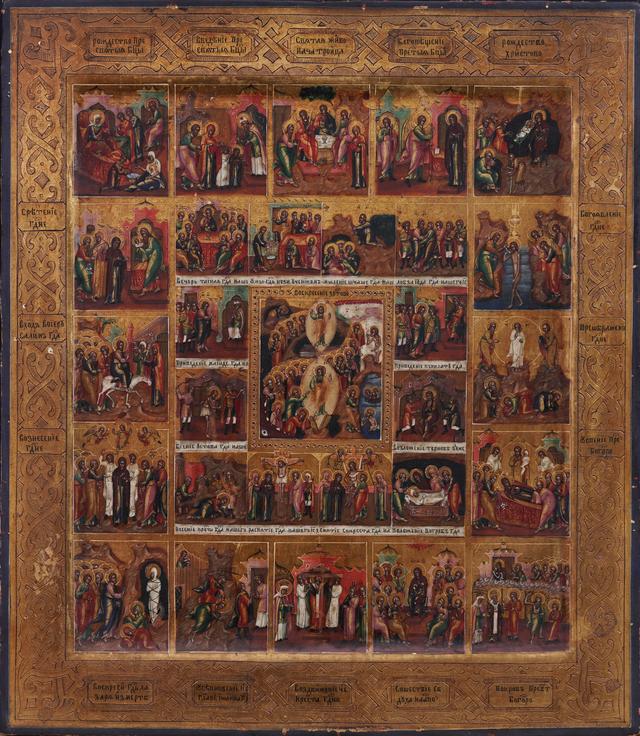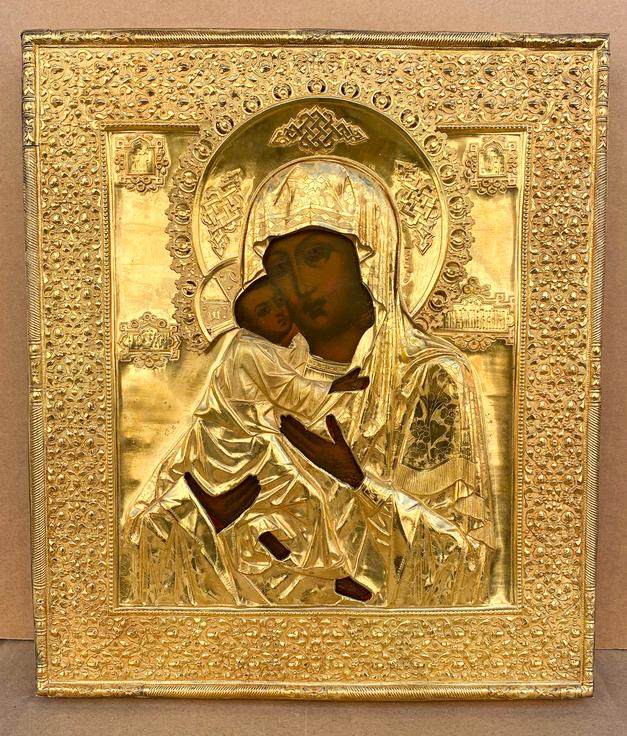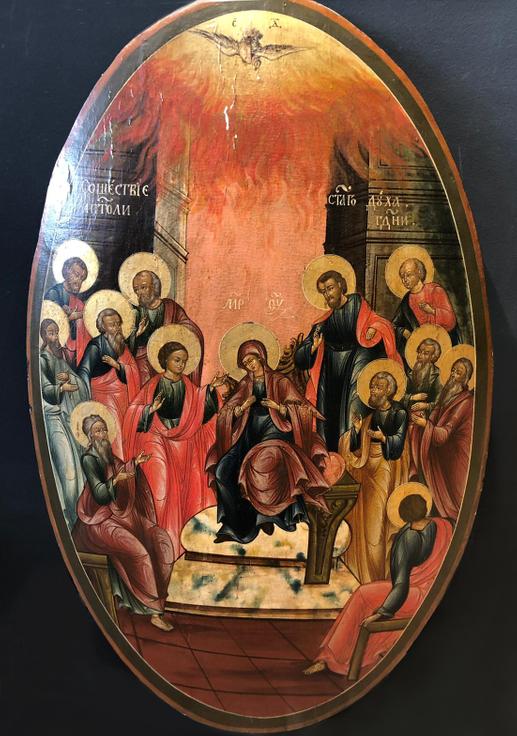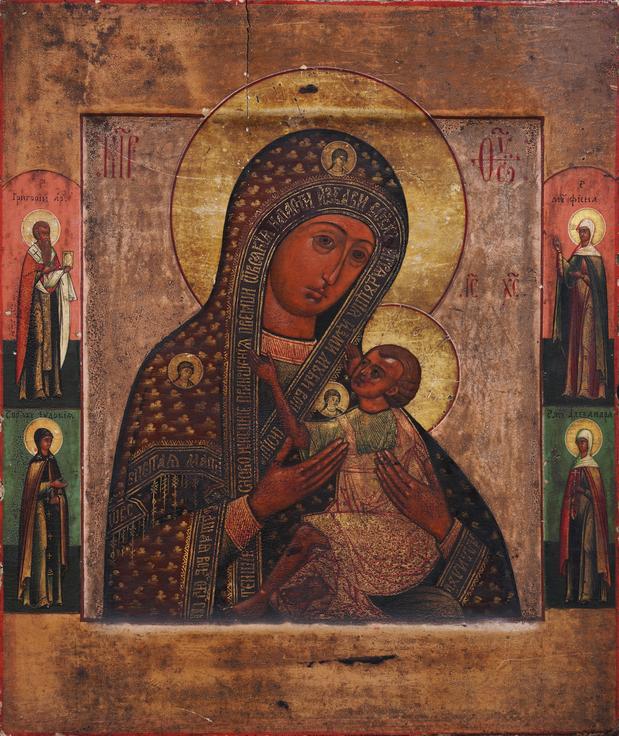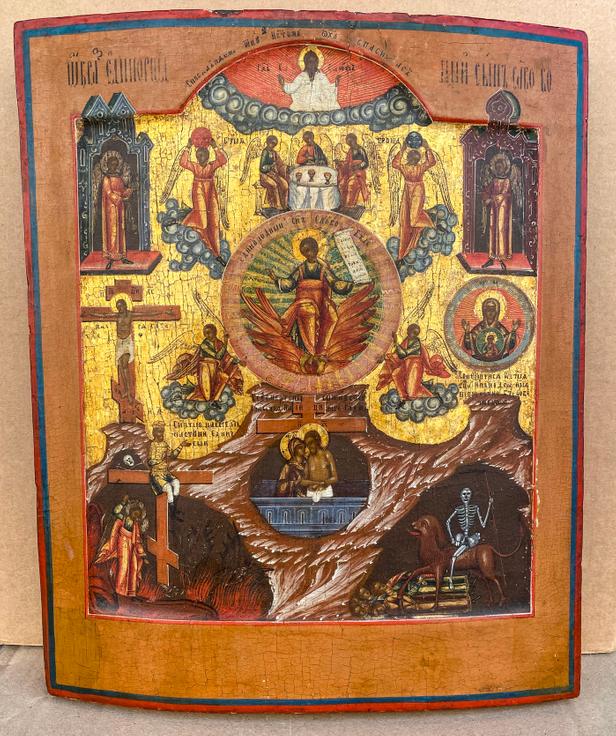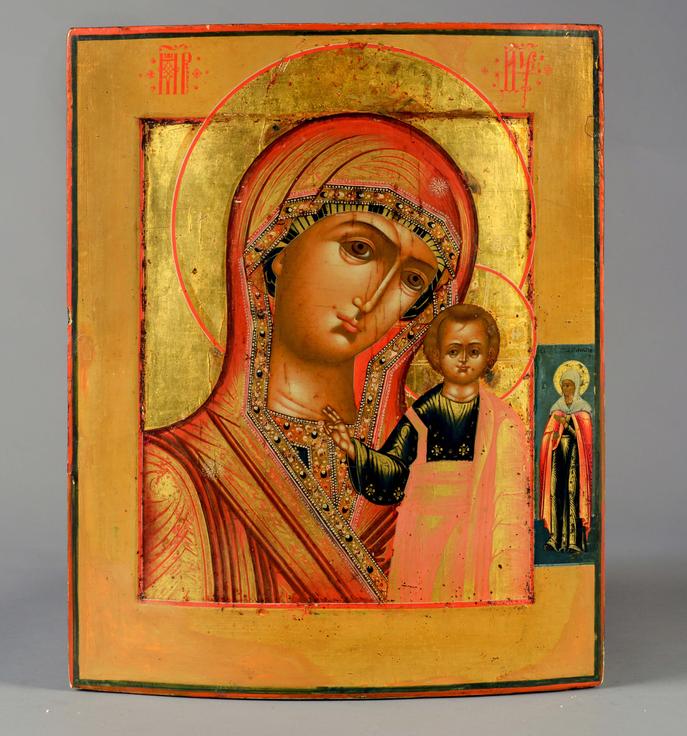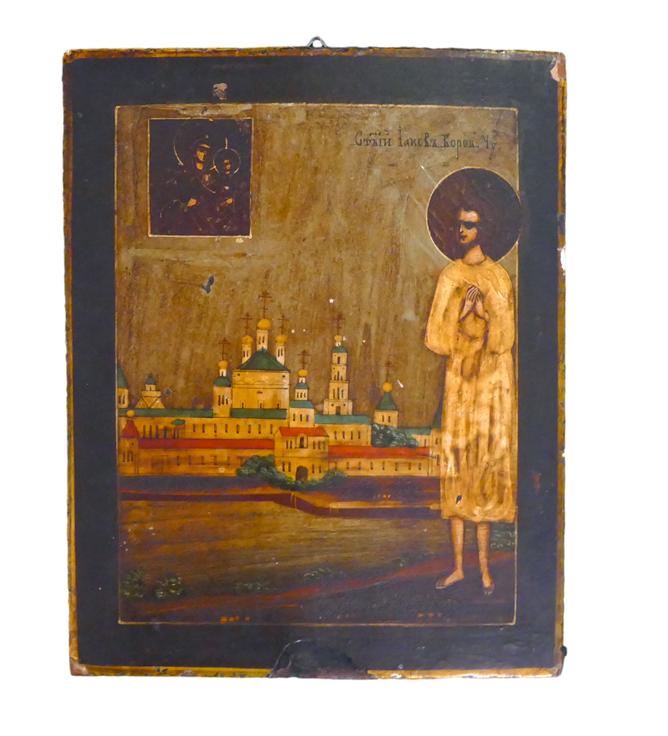Icons
PRIVATE SALES
& Other Services
Hermitage Fine Art offers private sales for clients who wish to buy and sell artworks outside of public auctions. We have access to a variety of important private collections worldwide in a range of categories including Fine Art, including Modern and Contemporary art, Photographs, Wines and Spirits, Timepieces, Jewelry, Design and Objects of Vertu, Russian and East European, silver and icons, and more.
If you wish to buy, our team will be able to find something that meets your wishes on demand by doing research and requesting expertise on your behalf. Alternatively, we can sell your collection discretely at prices that are mutually agreed between the two parties.
Other services
Moreover, we are able to put you in direct contact with art restorers, assist you with arranging optimal shipping plans and request the leading experts verification on your behalf.
For further information, please contact us directly by telephone or email.
For further information, please contact us directly by telephone or email.
Works available for
immediate purchase
Works available for
immediate purchase
 Enquire
Enquire
AN ICON «SAINT NICOLAS» WITH SAINTS
Ekaterinburg, mid 19 th century
AN ICON «SAINT NICOLAS» WITH SAINTS
Ekaterinburg, mid 19 th century
Wood, gesso, gold leaf, tempera
Oklad: sewing, beads, bugles
31 x 28 cm
Condition: in a good condition
This icon represents a significant collection value as an example of high artistic performance, originating from the Old Believer icon-painting workshops of the Urals.
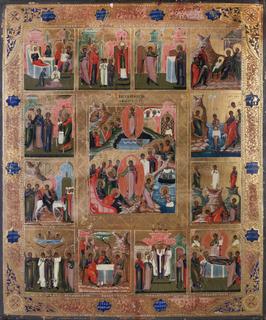 Enquire
Enquire
An icon ‘The Resurrection - Descent into Hades with Feasts’
Central Russia, late 19th century
An icon ‘The Resurrection - Descent into Hades with Feasts’
Central Russia, late 19th century
Wood, gesso, gold leaf, tempera
44 х 37,6 сm
Condition: no restoration, chipped edges, loss of gilding. Subtle elaboration of garments and personal attributes gives the icon a high artistic value. It is of considerable collector’s interest as a solemn Orthodox festive image.
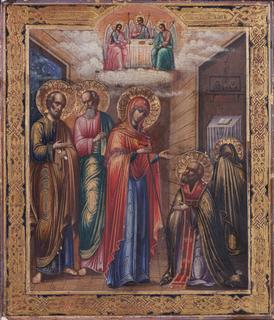 Enquire
Enquire
AN ICON «APPARITION OF THE SAINT VIRGIN MARY TO THE SAINT SEGIUS OF RADONEZH»
Palekh, end of 19th century
AN ICON «APPARITION OF THE SAINT VIRGIN MARY TO THE SAINT SEGIUS OF RADONEZH»
Palekh, end of 19th century
Wood, gold leaf, gold paint, tempera
31,2 х 26,4 сm
The composition is attractive in its pictorial diversity. The subtle elaboration of the garments and personalities grants the icon a high artistic value. The exquisite miniature painting, the elongated proportions of the figures, the bright colour palette, the masterly execution of the assistants and the ornaments on the clothes give the image a special festive decorative quality.
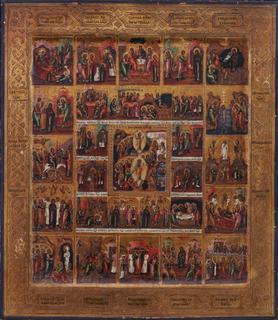 Enquire
Enquire
An icon ‘The Resurrection - Descent into Hades with Feasts’
and evangelical events in stamps
An icon ‘The Resurrection - Descent into Hades with Feasts’
and evangelical events in stamps
Rural area of Vladimir region, late 19th century
Wood, gesso, gold leaf, tempera
36 х 31,5 сm
Condition: good preservation, no restoration. Such a composition - the arrangement of the feasts in the stamps on the sides of the central image - is known in Russia since the second half of the 16th century. And it was already widespread in the 17th century. The main idea and central composition of the icon is devoted to the triumphant victory of Christ over death. The Twelve Great Feasts are the twelve most important feasts in Orthodoxy. Dedicated to the events of the earthly life of Jesus Christ and the Virgin Mary. Of considerable collector’s interest as an image executed in the «solemn» style with miniature painting in numerous stamps.
 Enquire
Enquire
AN ICON «THE VLADIMIRSKAYA MOTHER OF GOD» IN A SILVER-GILT OKLAD
Moscow, end of 19th century
AN ICON «THE VLADIMIRSKAYA MOTHER OF GOD» IN A SILVER-GILT OKLAD
Moscow, end of 19th century
Wood, gesso, tempera
Oklad: silver, chased, engraved, gilding
Maker’s mark “A. B.”; Assay master’s mark «A.S.» over the date 1869; coat of arms of the city of Moscow and silver mark “84”
31 x 27 cm
Condition: generally in a good condition, minor deformations of the Oklad
The presented icon is an early example of the Eleusa iconographic type of the Mother of God (in which the infant Jesus Christ is nestled against her cheek), known also as the Virgin of Tenderness. The icon Vladimirskaya Mother of God is the most celebrated in Russia and considered as the national palladium. Several miracles of historical importance such as deliverance from the invasions of enemies, are attributed to this icon. This icon appears in many legends and historical stories and it is the most copied icon among Russian icons of the Mother of God. The magnificent silver-guilt oklad, decorated with various ornamental motifs, gives particular value to the icon.
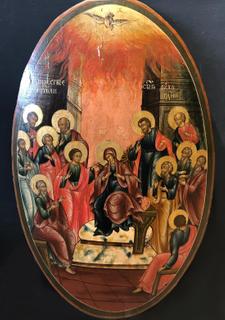 Enquire
Enquire
AN ICON «THE DESCENT OF THE HOLY SPIRIT ON THE APOSTLES”
Russia, Vladimir region, the first half of the 19th century
AN ICON «THE DESCENT OF THE HOLY SPIRIT ON THE APOSTLES”
Russia, Vladimir region, the first half of the 19th century
Wood, gesso, silver leaf, tempera
78 x 47.5 cm
Condition: fragmentary tinting
This iconography became widespread in the 18th century. The subject is one of the most important Christian Holy Days – the Pentecost, the Descent of the Holy Spirit upon the Apostles. The Mother of God is seated on the throne, surrounded by the apostles. Tongues of reddish-violet flame are descending from a dove - a symbol of the Holy Spirit. The style of the icon, distinguished by its special expressiveness, is a synthesis of the Baroque art of the outgoing era and the traditional icon-painting art characteristic of the first half of the 19th century. The icon “Descent of the Holy Spirit”, in a vertically elongated oval, was made for the festive row of the iconostasis
 Enquire
Enquire
An icon of Virgin ‘Most Holy Mother’ with saints Gregory, Agraphena(?), Eudocia and Alexandra
Moscow, end of 19th century
An icon of Virgin ‘Most Holy Mother’ with saints Gregory, Agraphena(?), Eudocia and Alexandra
Moscow, end of 19th century
Wood, gesso, gold leaf, tempera
Condition: no restoration, covered with a layer of darkened varnish, crack at the joint of the boards on the upper field.
The iconography of the Mother of God is known from the end of the 17th century from a drawing from an icon in the Sijsky iconographic original. Distinctive features of this rather rare iconography are the text of the Virgin’s Kondak, by whose first words the icon is called, placed on the ornamental border of Mary’s maforion.
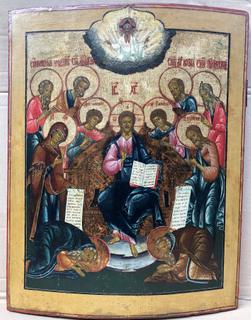 Enquire
Enquire
AN ICON «THE SAVIOUR ON THE THRONE, WITH THE MOTHER OF GOD, SAINT JOHN THE BAPTIST, ARCHANGELS MICHAEL AND GABRIEL AND SAINTS»
Ural (?), 2d half of 19th century
AN ICON «THE SAVIOUR ON THE THRONE, WITH THE MOTHER OF GOD, SAINT JOHN THE BAPTIST, ARCHANGELS MICHAEL AND GABRIEL AND SAINTS»
Ural (?), 2d half of 19th century
Wood, gesso, tempera
54 x 43 cm
Condition: the gold ground of the centerpiece and the gilding on the halos have been lost, after restoration
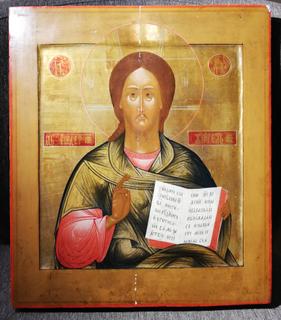 Enquire
Enquire
AN ICON «CHRIST PANTOCRATOR»
Kinechma (Russia), end of the 19th century
AN ICON «CHRIST PANTOCRATOR»
Kinechma (Russia), end of the 19th century
Wood, gesso, gold leaf, tempera
36 x 31 cm
Condition : generally in a good condition, vertical crack
The icon is notable for its archaic artistic language, expression and laconic manner of painting, for its rich colours, subtle and careful modeling of a «facial» painting
The Kazanskaya Mother of God is the most venerated variant of the Hodegetria (Directress) icon style in Russia. The original icon of Our Lady of Kazan was brought to Russia from Constantinople in the 13th century and then, the icon disappeared for more than a century. The icon was miraculously recovered in Kazan in 1579. Russian military commanders Dmitry Pozharsky (17th century) and Mikhail Kutuzov (19th century) attributed to the miraculous icon the help in saving the country from the Polish invasion of 1612, the Swedish invasion of 1709, and Napoleon’s invasion of 1812. The Kazanskaya Mother of God became the Holy Protectress of Russia. The icon was often chosen as a palladium of military regiments; many churches, altars and chapels were built in honour of the revelation of the Virgin of Kazan and in memory of the military events of the Russian history.
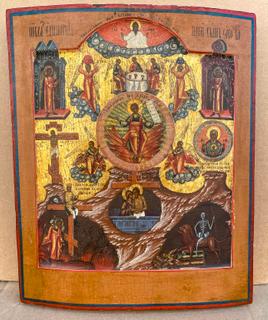 Enquire
Enquire
AN ICON «ONLY-BEGOTTEN SON»
Central Russia, end of the 19th century
AN ICON «ONLY-BEGOTTEN SON»
Central Russia, end of the 19th century
Wood, gesso, gold leaf, tempera
35 x 29.5 cm
Condition: after restoration
The icon is notable for its archaic artistic language, expression and laconic manner of painting, for its rich colours, subtle and careful modeling of a «facial» painting.
The iconography of the composition «Only-Begotten Son» dates back to the middle of the 16th century. These icons, called «theological-didactic» in literature, reflect the rationalist quest for faith characteristic of educated strata of Russian society in the 16th century, and illustrate attempts to interpret in painting the most important dogmas of the Orthodox Church.
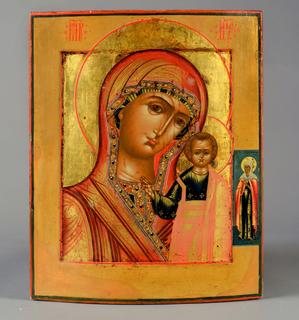 Enquire
Enquire
AN ICON «THE KAZANSKAYA MOTHER OF GOD» WITH SAINT TATIANA
Yaroslavl, mid-19th century
AN ICON «THE KAZANSKAYA MOTHER OF GOD» WITH SAINT TATIANA
Yaroslavl, mid-19th century
Wood, gesso, gold leaf, tempera
36.5 x 28.5 cm
Condition : generally in a good condition, fragmentary tinting on the gold of the Nimbus, tinting of the paint layer in the fields, on the back side there are some small circular holes produced by xylophagous insects.
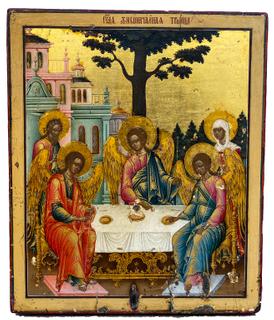 Enquire
Enquire
AN ICON «THE HOLY TRINITY OF THE OLD TESTAMENT»
Ural, second half of the 19th century
AN ICON «THE HOLY TRINITY OF THE OLD TESTAMENT»
Ural, second half of the 19th century
Wood, gesso, gold leaf, tempera
26 x 22.5 cm
Condition: in good condition, minor losses of the paint layer, candle burn on the lower margin, chips along the edges of the icon.
The icon is distinguished by the subtlety of writing, elegance, decorativeness, and an abundance of gold. The best examples of the Ural icon painting, to which the present icon certainly belongs, have absorbed their best features from the Old Russian icons: from the Moscow one - elongated proportions of figures, rhythm, ornamentation, writing on gold; from Yaroslavl - a three-dimensional, rounded image of faces and the dynamism of the subject.
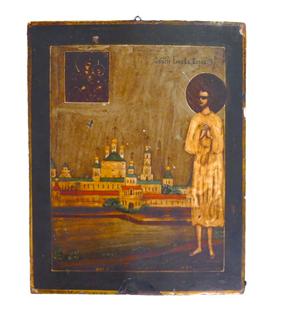 Enquire
Enquire
Icon of Saint Jacob Borovichsky
19th century
Icon of Saint Jacob Borovichsky
19th century
17.5 x 13.5 cm
The saint is depicted against the background of the Valdai Iversky Monastery, where his relics were kept.








